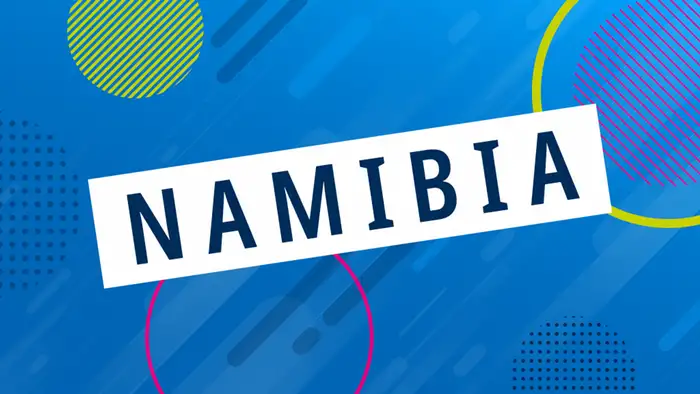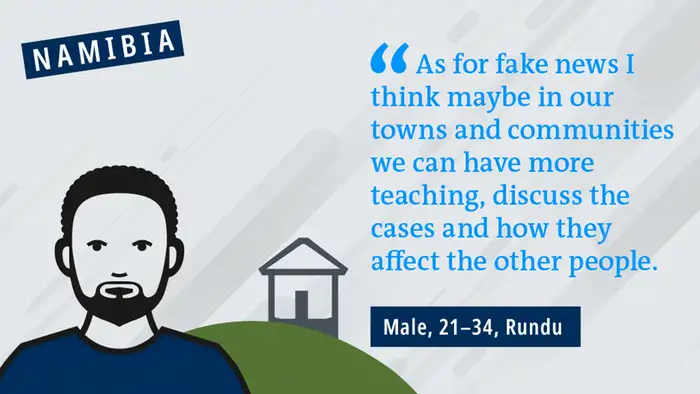Mil Index
Yearning for digital but not always media literate: Media and Information Literacy amongst Namibia’s youth
Namibia’s adolescents and young adults are confidently facing digital transformation but underestimate the benefits of traditional media.
Young Namibians are embracing the digital transformation, according to indicative findings from the present MIL INDEX country study. Interestingly, the youths that took part in eight focus groups conducted at the end of 2018 in Windhoek and Rundu are immersed in digital communication but are aware of the ambivalent nature of the news and information sources they find on social media and related Internet services. The importance of a critical mindset when navigating the World Wide Web was also stressed by the eight experts interviewed as part of the study.
TheMIL INDEX study summarized here addresses five dimensions of Media and Information Literacy (MIL) according to DW Akademie’s MIL model: access, analysis, reflection, creation, and action. In contrast to countries in which representative studies could be conducted (Kenya, Ghana, Burkina Faso), the methodology was mainly qualitative, relying on key informant interviews and focus groups. The findings presented are indicative of the state of MIL of young people in urban and peri-urban Namibia but cannot claim to be representative of the entire population. Additionally, there is no score or rating system that allows direct comparisons with the other countries in the overarching MIL INDEX project. Nevertheless, the results do give an indication of where the strengths and weaknesses of the 69 youths involved in the study lie.
Access
Media play an important role in the lives of Namibian youths today. The focus groups revealed that there is a rural/urban divide in access and use of media: the more rural (and older) groups using radio and television on a regular basis while the more urban (and younger) groups tended to regard journalistic media as passé. This is associated with the rise of social media, though it was interesting to find that Facebook and co. have become a prime news source for many whereas news apps are not prominent at all. Information uptake is coincidental and journalistic content is intermingled with all sorts of trivia when consumed in social networks. Smartphones are regarded by many as a substitute for newspapers, radio, and television. The youths thought newspaper websites were as informative as a printed newspaper. Amongst those who continued using traditional media, radio was turned to more often for information while TV was regarded more as an entertainment medium.
Several focus groups reflected critically on their own use of smartphones and social media, discussing aspects of addiction and of how online replaces more productive activities. There was also an element of solidarity with less privileged or impaired segments of the population for whom the youths believed traditional media were important.
Analysis
The Namibian youths that took part in the focus groups value their right to freedom of expression. There was a certain disenchantment with journalistic media, the reporting being considered not close enough to the interests and issues of the youths. They were able to formulate clear expectations regarding journalism in Namibia.
However, the most important finding in terms of analytical skills is that the focus group participants’ appraisal of media in terms of trustworthiness was the exact opposite of the media most of them used. While the discussions documented frequent use of social media these were evaluated as least trustworthy, whereas newspapers were rated highly on the trustworthiness scale but were hardly ever read. While there is an awareness of the ambivalent quality of news and information on social media, the youths could not always name sources they considered produced high-quality information. Some groups were aware of the fact that the quality of news one gets from social media is proportional to one’s own digital skills.
Remembering that the sample size was low and not representative, it is worth mentioning that the focus group participants had quite a good knowledge when it came to questions on social networks, journalism and their constitutional right to freedom of expression.
Reflection
The results of the focus groups in the reflection dimension were ambivalent. The youths demonstrated a clear awareness of issues such as cyberbullying and disinformation, being able to recount cases they had come across. But the accompanying survey showed that while they reject hate speech and disinformation, there is a certain willingness to accept cyberbullying as given. This was echoed in the focus groups where participants’ advice was often to ignore hateful messages, rather than do something about them.
That being said, the groups did discuss numerous other strategies in coming to terms with and combatting cyberbullying and disinformation. Rarely did they reflect the motivations that lay behind such behavior. It was also interesting to note that disinformation was mainly discussed about online rather than traditional media. Additionally, tribalism and racism were mentioned several times as negative phenomena in society, but never with reference to social media or the media in general.
Creation
The Namibian youths in the focus groups had a good grasp on basic skills when it comes to creating media. Taking photos, recording audio or video was done quite frequently. But, as the experts interviewed for the MIL INDEX highlighted, the technical skills often are not accompanied by an awareness of how to produce own media messages responsibly. Additionally, the skills were mostly used for trivial purposes (“impression management”) rather than for more ambitious goals. Advanced skills such as programming or writing blogs were not encountered.
Action
The action dimension was defined both as becoming active using media for the good of society and as using media for one’s own benefit. The youths displayed confidence in their ability to voice their concerns and express themselves using media. There was a mismatch between the perspective of the experts interviewed and the youths concerning whether youths were taken seriously by the media. While the experts thought this to be the case, the youths themselves did not feel adequately represented. This points to a blind spot in youth activism: Youths mainly mobilize via social media and thus, in the opinion of the experts neglect the opportunities journalistic media could offer.
The focus groups documented youths using media as sources of information on topics they were most interested in, such as politics, peace and stability, education, and health. They also used them for guidance and as an inspirational source when deciding what goals to pursue in life.
Conclusion
The above results indicate that there is a rural-urban divide in Namibia. Digital savvy urban youth are immersed in social media and mobile communication, though what they use and what they judge as trustworthy does not always match. They are aware of problematic types of digital communication, but are also prepared to take adverse behavior like cyberbullying for granted. For peri-urban / rural youth, traditional media like television and radio remain important sources of information, while there is a yearning for mobile / digital access. Youth activism often aims at the digital sphere, but experts encourage youth not to discount the relevance of journalistic media.
Methodological background
For each of the five dimensions (access, analysis, reflection, creation, action), survey respondents received a score ranging between 0 (= no skills whatsoever) and 20 (= highest level of skills) points. The scoring system measures how often certain skills are actually put into practice (access, creation, action) or tests the skills directly (analysis, reflection). Since citizens cannot permanently use media and information sources unless they are journalists or media workers, a perfect score of 100 for any country appears unrealistic—it is more about the relative performance across time, and in comparison to other countries, as well as being a tool for identifying deficits to be addressed in media development.
DW recommends
Downloads
- Date 22.10.2020
- Feedback: Send us your feedback.
- Print Print this page
- Permalink https://p.dw.com/p/3jvGV
- Date 22.10.2020
- Send us your feedback.
- Print Print this page
- Permalink https://p.dw.com/p/3jvGV


